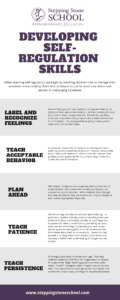Developing Self-Regulation Skills
Self-regulation, the ability to manage one’s own emotions and to empathize with others, is a leading predictor in the future academic success of a child. When children can self-regulate, they recognize when they are getting frustrated and can utilize strategies to help them calm down before it gets out of control.
When teaching self-regulation, we begin by teaching children how to manage their emotions and providing them with strategies to use to overcome stress and persist in challenging situations.

- Label and recognize feelings. From infancy, parents and teachers can support children by talking to them about their feelings and then assisting them
as they recover from strong emotions. For infants, soothing tones and responsive caregiving enables a child to learn how to self-regulate. Try singing softly or gently rocking with a child to help them calm down. - Teach acceptable behavior. In a stressful moment full of emotion, a child may not retain anything you try to teach about behavior. However, once a child has calmed, teach children to reflect on the situation and then problem-solve together by thinking of other ways to handle a similar situation in the future.
- Plan ahead. Going into new situations, like a doctor visit, it is beneficial to read stories and to role play how you can respond to a given situation. When children think through how they should act, they are much more likely to recognize and choose appropriate responses.
- Teach patience. Patient waiting describes an attitude about waiting. To promote a positive attitude, practice breathing exercises (Pretend to blow out birthday candles on your fingertips or pretend to blow up a balloon in your hand), do body exercises like stretching or pretending to have “sticky hands” (press hands together hard for 20 seconds and then slowly allow them to come apart). These activities provide a calming effect which lowers stress levels and can keep children calm while waiting for longer periods of time.
- Teach persistence Challenges arise daily no matter your age. Teaching children resilience amid life’s challenges leads to success throughout life. Begin teaching positive self-talk (child states, “I can’t.” Caregiver states, “maybe not yet, but you will.”) Talk about the many things he can accomplish and remind the child of many of things he has already learned.
Throughout the month of January, we will practice these and many other self-regulation techniques at Stepping Stone School as we participate in our Communities of Character Curriculum™activities. Children will play games and read stories about self-regulation as we focus on this important life skill.

Resources:
Florez, I. (2011, July). “Developing Young Children’s Self-Regulation through everyday experiences.” Young Children.P 46-51. Retrieved from https://www.earlychildhoodireland.ie/wp-content/uploads/2014/02/Self-Regulation_Florez_OnlineJuly20111.pdf
GreatSchools Staff. (1999). “Teaching Elementary Schoolers Self-Control.” Retrieved from http://www.greatschools.org/gk/articles/teaching-self-control-3rd-though-5th-grade/
Markham, L. (2015, June 11). “8 Steps to Help Your Child Develop Self Control.” Retrieved from https://www.ahaparenting.com/_blog/Parenting_Blog/post/Help_Your_Child_Develop_Self_Control/
Shanker, S. (2016, Jul 11).Self-Reg: Self-Regulation vs. Self-Control: The reason for the profound differences lies deep inside the brain. Retrieved from
https://www.psychologytoday.com/blog/self-reg/201607/self-reg-self-regulation-vs-self-control
Zero to Three. (2014). “Teaching Your Child Discipline and Self-control.” Retrieved from https:// main.zerotothree.org/site/PageServer?pagename=ter_key_social_selfcontrol